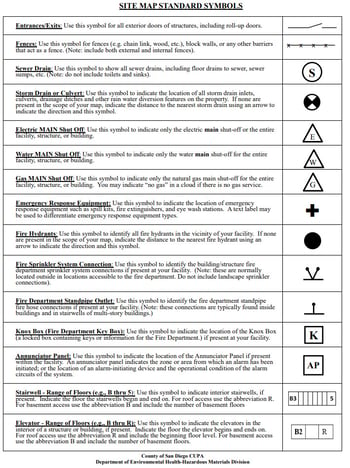A Hazardous Materials Business Plan (HMBP) is an important document that contains information about hazardous materials used on site at a facility.
In California, some companies are required to create a hazardous materials business plan, depending on the amount or type of hazardous waste on the facility’s premises.
The purpose of this plan is to provide important information about hazardous materials on site to first responders when there is a threat to public health and the environment. It also satisfies federal and state Community Right-to-Know Act laws that require industries to report on the storage and use of hazardous materials.
If your company is required to create an HMBP based on how much hazardous waste that is generated in your facility, below are the steps you will need to take to meet federal, state and local laws.
Know Your County’s Specific Requirements
 The state of California requires a facility to complete a hazardous material business plan if the company handles a certain amount of hazardous materials over the course of a year. These amounts are:
The state of California requires a facility to complete a hazardous material business plan if the company handles a certain amount of hazardous materials over the course of a year. These amounts are:
- 55 gallons in liquid form
- 500 pounds in solid form
- 200 cubic feet of compressed gas
Your facility must also create a HMBP if the materials being used are considered to be “extremely hazardous substances,” per Section 355.61 of Title 40 of the Code of Federal Regulations.
Additional state and federal requirements are outlined in this Governor’s Office of Emergency Services document. It’s important to note that some counties in California have stricter requirements such as the amount of a chemical that must be included in a facility’s plan. Facilities located in counties that do not have threshold amounts can refer to the California Health and Safety Code for guidance.
Compile And Submit The Plan
California’s Health and Safety Code establishes standards that must be included in a HMBP. Because local authorities may have additional requirements, it is important to check with your local government agency to determine any additional components that must be included in a plan.
In general, HMBPs include four elements:
- Business activities and owner identification
- Hazardous material inventory
- A site map
- An emergency response plan and employee training
Business Activities And Owner Identification
This part of your HMBP should be pretty straight-forward and is a form found in the facility information section of the California Environmental Reporting System (CERS). This form includes business activities conducted at the facility, as well as information about the owner/operator.
Hazardous Material Inventory
This portion of your HMBP is a list of all the hazardous materials present at your facility that are subject to reporting. These inventory forms must be completed and submitted through CERS as well.
Your list must include all hazardous substances on site and stored in underground tanks. One way to recognize any inventory that is hazardous is by the Safety Data Sheets (SDS) that are provided by the manufacturer, as required by law. SDS documents contain:
- The substance’s chemical composition
- Fire and explosive potential
- Any health hazards
- Reactive characteristics
- Emergency procedures
- Special protection and precautions that should take place
Reported inventory also must include extremely hazardous substances that are in quantities equal to or greater than the “Threshold Planning Quantities,” which are established in the Federal Register or on the EPA website.
Site Map
Facilities must develop a site map in the event that an emergency occurs and responding personnel must locate hazardous materials. This map, which must be submitted to Certified Unified Program Agencies (CUPA) through CERS, should include items such as:
- Loading areas
- Internal roads and adjacent streets
- Storm and sewer drains
- Access and exit points, including driveway entrances and parking lots
- Emergency shutoffs
- Evacuation staging areas
- Hazardous material handling and storage areas
- Fire hydrants and other connections
- Emergency response equipment, such as fire extinguishers and spill kits
 Standard site map symbols should be used. Show structures from above. If a facility is larger in size, multiple pages can be used. For example, one page could include the overall facility layout, and additional pages could focus on each building individually.
Standard site map symbols should be used. Show structures from above. If a facility is larger in size, multiple pages can be used. For example, one page could include the overall facility layout, and additional pages could focus on each building individually.
Indicate on the map the North direction, and be sure to label any adjacent properties, especially if they are schools, parks or residential areas.
Check with your local county for rules on using color versus black and white, and whether there are any requirements on whether maps must be drawn on a computer or by hand.
Emergency Response Plan And Employee Training
This portion of the HMBP outlines the facility’s emergency training program and a plan that should be put into action if an emergency occurs.
According to the Health and Safety Code, employees should be trained in disaster preparedness when they are first hired and should be given annual refresher training courses.
Training programs should ensure employees are familiar with the facility’s emergency response plan and should include notification procedures should an emergency occur. The facility’s emergency response plan should include procedures to mitigate harm to employees, the public and the environment.
Not having a proper plan in place can be costly and lead to major fines. Our article, No Hazardous Waste Contingency Plan Leads To Big Fine For Manufacturer, shows why it is important to adequately train staff and have an emergency plan in place.
Review Accuracy
Businesses change, and so may the amount of hazardous materials stored on site. After initially submitting a HMBP through CERS, companies should review the accuracy of their plan on an annual basis.
This is important because any change in hazardous material use or location could impact an emergency response.
Government hazardous materials divisions that inspect facilities will compare materials on site with what is outlined in the HMBP. If any parts do not align, a facility will need to update its HMBP within a certain time period or face fines.
A Critical Component
Facilities that generate hazardous waste and store hazardous materials on site are responsible for these substances from the moment they are generated to their final disposal. Called cradle to grave, this responsibility is critical to ensure the safety of the public and environment.
Creating a hazardous material business plan is a critical component of this requirement since it outlines information about each substance at the facility in the event an emergency occurs. Not having an HMBP can be costly - not only to your facility in the form of fines, but to the safety of employees and first responders as well.
If you need help, contact a hazardous waste disposal company. They can help you create a plan and review your processes to make sure you aren't in violation of any regulations.


Comment